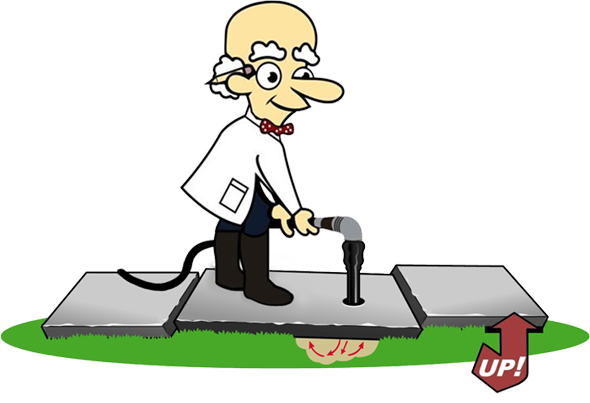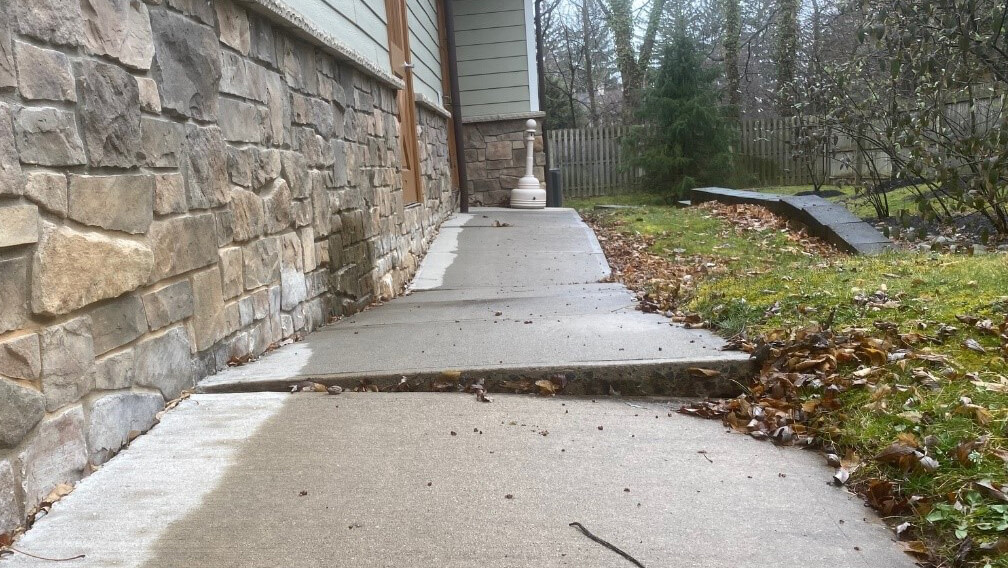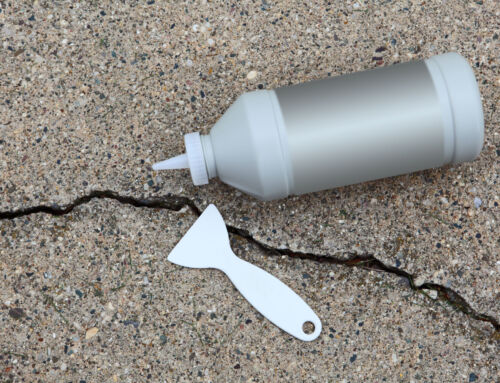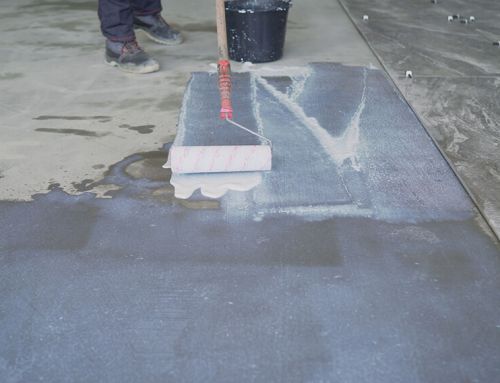IN THIS ARTICLE
Concrete Settlement in New Jersey – Causes, Signs, and How We Fix It with Mudjacking
Concrete is supposed to be strong and long-lasting, but over time, it can shift, sink, and crack. When that happens, it’s usually because of concrete settlement — a process where the slab moves downward due to changes in the soil beneath it.
We’ve been fixing settled concrete across New Jersey for over 20 years, and we’ve seen just about every cause and every type of damage it can create. Whether it’s your driveway, sidewalk, garage floor, patio, or interior slab, the signs of settlement are easy to spot if you know what to look for — and catching them early can save you thousands of dollars in repairs.
In this guide, we’ll explain:
-
What concrete settlement is
-
Why it happens (common causes in NJ)
-
How to recognize the warning signs
-
How we fix it using mudjacking — a proven method used for decades
-
How to prevent settlement in the future
We’ll keep things straightforward, so you know exactly what’s going on under your slab and what can be done to fix it.
What is Concrete Settlement?
Concrete settlement happens when the ground beneath a slab shifts, compresses, or washes away, causing the slab to sink. When that support is gone, the heavy weight of concrete naturally forces it downward, often leading to cracks, uneven surfaces, or a noticeable slope.
In many cases, settlement starts within the first 10 years after a property is built — especially if the soil wasn’t compacted properly during construction. But it can also happen decades later due to erosion, water problems, or natural soil changes.
In New Jersey, where we work, the type of soil and weather patterns play a big role. We deal with a mix of clay, silt, and sandy soils. Clay expands when wet and shrinks when dry, sandy soils wash out more easily, and silt can shift under heavy loads. This constant movement puts stress on your concrete over time.
Causes of Concrete Settlement
Over the years, we’ve identified several common reasons slabs sink in NJ. Often, more than one factor is involved.
Soil Shrinkage and Swelling
Certain soils, especially clay-rich soils, expand when they absorb water and shrink when they dry out. This seasonal movement causes slabs to lift slightly in wet weather and settle in dry conditions. Over time, the net effect is usually a gradual drop in elevation.
We see this a lot in areas where droughts are followed by heavy rain. The shrink-swell cycle creates small gaps beneath the concrete, which eventually lead to settlement.
Poor Soil Compaction
Before a slab is poured, the soil underneath should be compacted so it can bear the load. If this step is skipped or done poorly, the soil can compress over time, creating empty space.
Poor compaction is especially common around new homes. During construction, trenches are dug for foundations, utilities, or plumbing, and these areas are backfilled. If the backfill isn’t compacted properly, settlement usually starts within a few years.
Erosion
Water is one of the biggest enemies of concrete stability. Poor grading, downspouts that discharge right next to slabs, or clogged gutters can all cause water to pool near the concrete.
When that water flows beneath the slab, it can wash away fine particles in the soil — especially sandy or silty soils. Over time, erosion creates voids under the concrete, and the slab begins to drop.
Organic Material Decay
Sometimes, builders pour concrete over buried tree stumps, roots, or even construction debris. As these organic materials break down, they leave empty spaces in the soil. This decay process can take years, but eventually the slab loses support and sinks.
We’ve also seen patios settle after nearby trees were removed. When the roots rot underground, they leave hollow pockets that cause the slab above to collapse slightly.
Water Infiltration from Below
In some cases, water comes from underneath — not just from surface runoff. This can happen if you live in an area with a high water table, or if underground springs shift and erode the supporting soil.
Prolonged saturation weakens soil structure, especially in clay and silt, making it less able to hold up the slab.
Burrowing Animals
In parts of NJ, burrowing pests like chipmunks, moles, and groundhogs create tunnels under driveways, walkways, and patios. While one small tunnel won’t immediately cause a slab to sink, repeated burrowing can weaken the soil to the point where settlement occurs.
We’ve lifted plenty of sidewalks where animal burrows were the main culprit.
Plumbing Leaks
If a water or sewer line runs under your slab, a slow leak can go unnoticed for months or even years. Meanwhile, water seeps into the surrounding soil, carrying fine particles away. Eventually, this erosion leads to settlement.
Recognizing Concrete Settlement: Identifying signs of concrete settlement is crucial for timely intervention. Common indicators include:
Cracks:
Visible cracks on the surface of concrete or along walls, regardless of their orientation – vertical, horizontal, or diagonal, indicate settling and should be dealt with immediately.
Uneven Surfaces:
Irregular seams or a slanted concrete floor indicate that the concrete slab has subsided and is leaning. Another sign is a cement line on a wall above the level of the concrete floor slab. This is common in garages with floor settlement.
Doors and Windows Misalignment:
Concrete floor settlement in homes or buildings can lead to misaligned doors and windows, making them challenging to operate. Signs of settlement may also be visible through cracked sheetrock walls or a space between the concrete floor and a wall’s base trim molding.
Pooling Water:
Water collecting around the base or on a concrete slab area could indicate that the ground is sinking. This sinking can cause water not to pitch or drain properly away from the house.
We recommend checking high-traffic areas like driveways, garage floors, and patios every few months — especially after heavy rain or a freeze-thaw season.
How We Fix Settlement with Mudjacking
We repair settled slabs using a method called mudjacking (also called slabjacking). This is a time-tested process that’s been used successfully for almost a century — long before newer methods came along.
The concept is simple: we pump a specialized slurry mixture under the slab to fill voids and lift it back to its original position. But the process takes skill and precision to get right.
Here’s how we do it:
Step 1 – Inspection
First, we assess the slab to figure out why it settled and how much lift it needs. We also look for signs of ongoing water problems so we can address them at the same time.
Step 2 – Drilling Access Holes
We drill small holes (about the size of a quarter) in strategic spots across the slab. These give us access points to pump the mudjacking slurry beneath the concrete.
Step 3 – Pumping the Slurry
Using specialized equipment, we pump our cement-based slurry into the voids. As it fills the empty space, the pressure gently raises the slab. We monitor the lift closely to avoid over-raising.
Step 4 – Patching the Holes
Once the slab is level, we fill the access holes with a matching concrete mix so they blend in.
Step 5 – Addressing the Cause
Mudjacking fixes the slab, but we also look at what caused the settlement. This might mean improving drainage, extending downspouts, or recommending soil compaction if new slabs are planned.
Why We Use Mudjacking in NJ
We choose mudjacking over other methods because:
-
It’s Proven – It’s been used for decades with long-term success.
-
It’s Cost-Effective – Usually far cheaper than tearing out and replacing concrete.
-
It’s Strong – Our cement-based mix restores support under the slab.
-
It’s Fast – Most jobs are completed in a few hours, and the slab is ready for use almost immediately.
Preventing Future Settlement
After your slab is lifted, you want it to stay that way. Here are some ways we help customers protect their investment:
-
Improve Drainage – Ensure water flows away from your concrete. We often recommend grading the soil or extending downspouts.
-
Fix Gutter Problems – Keep gutters clear so water doesn’t spill over and soak the soil.
-
Control Runoff – Redirect water from sprinklers or hoses so it doesn’t pool near slabs.
-
Address Animal Activity – Fill in burrows and use deterrents to keep pests away from the slab.
-
Inspect Regularly – Check for cracks, water pooling, or changes in slope.
We’ve been lifting and leveling concrete in NJ for more than 20 years. We work in most cities and towns across the state, and we know the local soil conditions inside out. From shore towns with sandy soils to inland areas with heavy clay, we tailor our mudjacking mix and approach to the site conditions.
We’ve fixed:
-
Driveways in Bergen and Essex counties
-
Patios in Monmouth and Ocean counties
-
Garage floors in Morris and Somerset counties
-
Walkways and steps in Union, Middlesex, and Mercer counties
No matter where you are, we bring the same level of care, attention to detail, and practical problem-solving that has kept us in business for over two decades.
If your concrete is sinking, don’t wait for the cracks to get bigger or for water to start pooling. The earlier you fix it, the less it costs — and mudjacking is one of the most effective, proven, and budget-friendly solutions available in NJ today. Contact us for a professional concrete settlement evaluation in New Jersey or find more related articles on our Learning Center.
- How We Raised a Sunken Concrete Walkway in Sewell, NJ - November 20, 2025
- Carbon Fiber Foundation Repair: All You Need to Know - November 20, 2025
- 5 Common Causes of Concrete Porch Collapse (and How to Prevent It) - November 20, 2025








